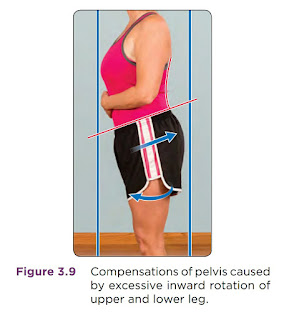- A. when the knee collapses in toward the midline of the body(a valgus position)
- B. toward the outside of the body (a varus position);
- Tracking Problems of the knee during flexion and extension can occur when the kneecap does not glide smoothly over the bottom of the femur (femoral groove). Tracking problems place an abnormal amount of pressure on the underside of the kneecap. Over time, this excessive pressure can cause inflammation and irritation, resulting in pain and dysfunction.
Assessment Process
- Verbal Assessment
b) past injuries or surgeries.
c) Patient’s level of physical activity.( help you to gauge the amount of stress he places on his knees during a typical day or week.
d) Patient’s Occupation (important to know if someone is a gardener or a carpet layer who kneels all day long. Kneeling can put a lot of stress on the kneecap.)
e) Does Pain limits engaging in Daily Activity?
f) Ask whether the client’s knee pain occurs with any other pains or symptoms. (This will help the client to understand the body’s interconnectedness.)
g) Aggravating Factors & Reliving factors.
- Visual Assessment - Ask Patient to Stand Facing You With Both Legs Hip Width Apart.
- Next observe Side to Side Alignment this Is done in Two Parts,
1st static (Standing) & 2nd Dynamic
(Single leg Squat).
In Both Process Observe For Knee Deviation from Side to side. (Valgus
Or Varus)

Note - Do not ask clients with severe knee pain to do a single-leg squat. This will add stress to the knee, and it may make their condition worse. Simply perform the static visual assessment to get an idea of the placement of the Centre of the kneecap .
- Salsa Dance Hip - Ask the client to stand on one leg facing away from you and to squat to about 30 degrees. Watch the Centre of the buttock or the sit bone (ischial tuberosity) as she performs this movement. Ideally, as the client squats, the Centre of her gluteus maximus muscle should lower down just to the side of the Centre of her heel. There may be an indication of knee alignment problems if the glutes and hip move excessively in a swishing “salsa dance hip” movement away from the Centre line of the body.
- Hands on assessment - The thighbone is naturally angled inward toward the knee. Therefore, the knee joint should be positioned closer to the midline than the Centre of the hip. This angle of the thighbone in relation to the Centre of the knee, called the Q angle.
- Q angle in males of more than approximately 15 degrees is considered abnormal, and a Q angle of more than 18 degrees in females is also considered abnormal (a greater angle is allowed in females due to their wider hips). Q Angle gives idea about Degree of Deviation.
- Patella Tracking Issue - Ask the Patient to lie on the ground on her back.
Kneel beside Patient and Teach to bend one knee.
↓
Place one hand on the client’s kneecap and use your other hand to bend and straighten the leg two to three times
↓
Do not press down excessively on either the kneecap or the lower leg as you perform this assessment.
↓
As you bend and straighten the leg, feel the kneecap as it glides over the bottom of the upper leg.
If you hear or feel any grinding, crunching, cracking, or popping, then there is probably a tracking issue. If the client experiences pain of any kind, stop the assessment immediately.
HOW THE KNEES RELATE TO THE FEET AND ANKLES AND THE LUMBO PELVIC
HIP GIRDLE
· The knee is the structure that bridges the feet and ankles and the lumbo-Pelvic Girdle.
-pelvic hip girdle. Therefore, any imbalances or malalignments in the structures above or below it will directly affect how the knee above or below it will directly affect how the knee feels and functions.
· For example, during the single leg squat assessment, you should have noticed that a valgus knee is usually accompanied by overpronation of the foot and ankle complex. This is because as the foot and ankle collapse toward the midline during overpronation,
the lower leg also rotates inward excessively, pulling the knee into a valgus position. This movement of the knee also causes the thighbone to rotate inward, affecting the position of the hip socket (where the upper leg articulates with the pelvis – Acetabulum ). Because of this change in position of the upper leg and hip socket, the pelvis shifts out of alignment by rotating down and forward . This change in position of the pelvis causes the lower back to arch excessively.Thank you so much for reading





Comments
Post a Comment